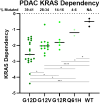Evaluation of KRAS inhibitor-directed therapies for pancreatic cancer treatment
- PMID: 38800401
- PMCID: PMC11116577
- DOI: 10.3389/fonc.2024.1402128
Evaluation of KRAS inhibitor-directed therapies for pancreatic cancer treatment
Abstract
Despite significant advancements in the treatment of other cancers, pancreatic ductal adenocarcinoma (PDAC) remains one of the world's deadliest cancers. More than 90% of PDAC patients harbor a Kirsten rat sarcoma (KRAS) gene mutation. Although the clinical potential of anti-KRAS therapies has long been realized, all initial efforts to target KRAS were unsuccessful. However, with the recent development of a new generation of KRAS-targeting drugs, multiple KRAS-targeted treatment options for patients with PDAC have entered clinical trials. In this review, we provide an overview of current standard of care treatment, describe RAS signaling and the relevance of KRAS mutations, and discuss RAS isoform- and mutation-specific differences. We also evaluate the clinical efficacy and safety of mutation-selective and multi-selective inhibitors, in the context of PDAC. We then provide a comparison of clinically relevant KRAS inhibitors to second-line PDAC treatment options. Finally, we discuss putative resistance mechanisms that may limit the clinical effectiveness of KRAS-targeted therapies and provide a brief overview of promising therapeutic approaches in development that are focused on mitigating these resistance mechanisms.
Keywords: KRAS; KRAS inhibition; KRAS inhibitor; PDAC; pancreatic cancer.
Copyright © 2024 Long, Amparo, Goodhart, Ahmad and Waters.
Conflict of interest statement
The authors declare that the research was conducted in the absence of any commercial or financial relationships that could be construed as a potential conflict of interest.
Figures


Similar articles
-
Targeting KRAS in pancreatic cancer: new drugs on the horizon.Cancer Metastasis Rev. 2021 Sep;40(3):819-835. doi: 10.1007/s10555-021-09990-2. Epub 2021 Sep 9. Cancer Metastasis Rev. 2021. PMID: 34499267 Free PMC article. Review.
-
Small Molecule KRAS Inhibitors: The Future for Targeted Pancreatic Cancer Therapy?Cancers (Basel). 2020 May 24;12(5):1341. doi: 10.3390/cancers12051341. Cancers (Basel). 2020. PMID: 32456277 Free PMC article.
-
PRMT5 inhibitors: Therapeutic potential in pancreatic cancer.Transl Oncol. 2025 May;55:102366. doi: 10.1016/j.tranon.2025.102366. Epub 2025 Mar 28. Transl Oncol. 2025. PMID: 40157258 Free PMC article. Review.
-
Moving Towards Dawn: KRas Signaling and Treatment in Pancreatic Ductal Adenocarcinoma.Curr Mol Pharmacol. 2022;15(7):904-928. doi: 10.2174/1874467215666220128161647. Curr Mol Pharmacol. 2022. PMID: 35088684 Review.
-
Oncogenic ERBB2 aberrations and KRAS mutations cooperate to promote pancreatic ductal adenocarcinoma progression.Carcinogenesis. 2020 Mar 13;41(1):44-55. doi: 10.1093/carcin/bgz086. Carcinogenesis. 2020. PMID: 31046123
Cited by
-
A novel regimen for pancreatic ductal adenocarcinoma targeting MEK, BCL-xL, and EGFR.Neoplasia. 2025 Jan;59:101070. doi: 10.1016/j.neo.2024.101070. Epub 2024 Nov 14. Neoplasia. 2025. PMID: 39541736 Free PMC article.
-
Early neoplastic lesions of the pancreas: initiation, progression, and opportunities for precancer interception.J Clin Invest. 2025 Jul 15;135(14):e191937. doi: 10.1172/JCI191937. eCollection 2025 Jul 15. J Clin Invest. 2025. PMID: 40662372 Free PMC article. Review.
-
Macrophages and fibroblasts as regulators of the immune response in pancreatic cancer.Nat Immunol. 2025 May;26(5):678-691. doi: 10.1038/s41590-025-02134-6. Epub 2025 Apr 22. Nat Immunol. 2025. PMID: 40263612 Free PMC article. Review.
-
Recent Advances and Challenges in the Treatment of Advanced Pancreatic Cancer: An Update on Completed and Ongoing Clinical Trials.Cancers (Basel). 2025 Apr 14;17(8):1319. doi: 10.3390/cancers17081319. Cancers (Basel). 2025. PMID: 40282495 Free PMC article. Review.
-
Emerging role of exosomes in cancer therapy: progress and challenges.Mol Cancer. 2025 Jan 13;24(1):13. doi: 10.1186/s12943-024-02215-4. Mol Cancer. 2025. PMID: 39806451 Free PMC article. Review.
References
Publication types
Grants and funding
LinkOut - more resources
Full Text Sources
Miscellaneous

